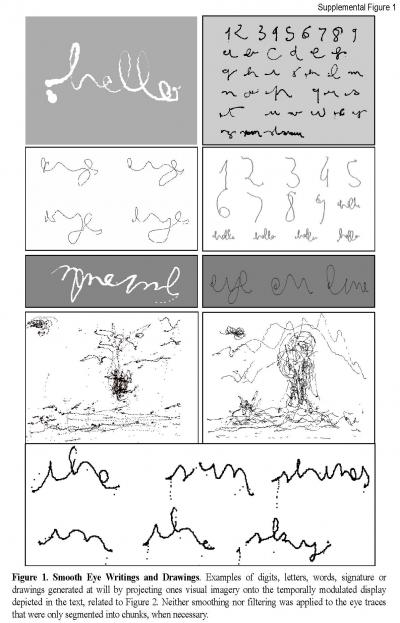“One can also imagine that, on the long term, eye movements can routinely be used in man-machine interactions”, and doubtless, Jean Lorenceau’s research into ways to improve the lives of the physically disabled will soon be co-opted by the next-generation of HUD-enabled mobile communications companies. But between the the advent of eyeball-controlled augmented reality headsets and now, let’s wish Monsieur Lorenceau the best of luck with getting his technology where it’s needed, and a resounding ‘Bravo’ to the man.
A new technology described in the paper published online on July 26 in Current Biology, a Cell Press publication, might allow people who have almost completely lost the ability to move their arms or legs to communicate freely, by using their eyes to write in cursive. The eye-writing technology tricks the neuromuscular machinery into doing something that is usually impossible: to voluntarily produce smooth eye movements in arbitrary directions.
“Contrary to the current belief, we show that one can gain complete, voluntary control over smooth pursuit eye movements,” says Jean Lorenceau of Université Pierre et Marie Curie-Paris. “The discovery also provides a tool to use smooth pursuit eye movements as a pencil to draw, write, or generate a signature.”
The advance could be of great benefit for people deprived of limb movements, such as those with Lou Gehrig’s disease (also known as ALS), the researchers say. It might also help to improve eye movement control in people with certain conditions such as dyslexia or ADHD and/or for experts, such as athletes or surgeons, whose activities strongly rely on eye movements.
in fact our eyes never cease to move
In everyday life, smooth pursuit eye movement is used to track moving targets, Lorenceau explains. While people do have the ability to move their eyes in exquisitely sophisticated ways—and in fact our eyes never cease to move—it is normally impossible to control those movements smoothly in any direction.
Lorenceau’s team got a hint that smooth eye movements just might be possible in a completely accidental way. He was moving his own eyes in front of an unusual visual display in his lab and discovered that it produced some odd effects. For one thing, he could see his own eye movements. With a little practice, he gradually discovered that he could control those eye movements, too.

These are examples of digits, letters, words, signature or drawings generated at will by projecting ones visual imagery onto the temporally modulated display depicted in the text. Neither smoothing nor filtering was applied to the eye traces that were only segmented into chunks, when necessary.
Credit: Lorenceau et al., Current Biology
The technology relies on changes in contrast to trick the eyes into the perception of motion. When viewing that changing visual display, people can learn to control their eye movements smoothly and at will, the new study shows. It doesn’t take very much practice either.
“One can also imagine that, on the long term, eye movements can routinely be used in man-machine interactions,” Lorenceau says.
Lorenceau is now working on a better version of his eye writer, and tests with ALS patients should start next year.
Source: Cell Press

The aim of art is to represent not the outward appearance of things, but their inward significance. – Aristotle





















